skip to main |
skip to sidebar
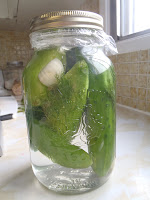 Cucumbers
Cucumbers
I come from a land of "refrigerator pickles": cucumbers steeped in syrupy vinegar and spices, and stored in the fridge through the fall. The idea of producing an acidic pickle with only brine was a revelation.
The procedure couldn't be simpler. Make a brine of one cup salt in one gallon of water. Cover your chosen vegetables in the chilled brine (most vegetables want to float, so you'll have to find a way to keep them submerged) and leave for a week at a cool room temperature. This is the only tricky part: the solution must stay below 23°C to prevent the proliferation of harmful bacteria. I don't have any air-conditioning, so I wait for weeks like this, when it barely reaches 20°C outside, and then crack open the window in my "cold storage room" (also my office, where I am typing this post).
The familiar Lactobacillus bacteria consume something (lactose?) in the vegetables and create lactic acid. Lactobacillus can survive in the saline solution, while most undesirable bacteria can't.
Once the vegetables have reached the desired balance of salty and sour, they are removed from the brine and placed in a new container. The brine is boiled to kill off any pathogens, then chilled and poured back over the vegetables. The pickles will keep indefinitely in your fridge.
That is my only misgiving about this preservation technique: the pickles are not properly canned, and so they tie up fridge space. The bulk of my cucumbers are cooked into syrupy relish, properly canned, and kept in the pantry. It's worth saving a few vegetables for this natural pickling process. The taste is exquisite: delicate acidity and a high crunch-factor.
Cabbage
We're starting to get 5lb heads of cabbage from Tipi Creek. While I have a gargantuan appetite for braised cabbage at this time year (apples come into season, I smoke pork, maybe there's some kohlrabi kicking around...) there's still plenty left over to make sauerkraut by the traditional brining method. This year I tried canning my sauerkraut. Sauerkraut is often cooked before eating anyways, so I figured it will hold up to the canning process nicely.
There's still a nagging voice in the back of my mind, a voice insisting that canning without a recipe is dangerous.
I need a book that liberates me, the home-canner, from recipes. A book that says: "This is the pH, salinity, or sugar content required to safely jar food. This is how to measure the pH of your pickles. This is the approximate pH of common household pantry items. This is how to calculate the pH of your pickling solution." That way, instead of working from a recipe, I could start with a set of ingredients or cured products like sauerkraut and salt pork and test and adjust them to make sure they're safe to can.
Even though I didn't have a recipe for the canned sauerkraut, there are plenty of forums and Youtube videos from the northern US that detail the jarring of traditional home-cured sauerkraut. All the folks in these videos have friendly, trustworthy faces, so I gave it a go.
This week I made a pâté dish featuring two products from Greens, Eggs, and Ham. The main component of the pâté was duck livers from unfattened ducks (ie. not foie gras, just normal livers). The pâté was then served with sour cherries from the same farm (several of which are apparently languishing, unpicked, for want of labourers).
Pâté is a dish that suffers from misunderstanding because of the highfalutin language surrounding its preparation. A pâté is a glorified meatloaf: it is ground meat that has somehow been bound together. That's it.
Within that definition, there is a spectrum that runs from "rustic" to "refined". The two qualities that decide a pâté's place on the spectrum are texture and ingredients. Rustic pâtés are coarser in texture and made with cheaper, heartier ingredients, like liver. They are often described by words like campagne ("country"), grandmère ("grandma"), and maison ("house"). Refined pâtés have a finer, creamier texture and feature meat more prominently than liver. The following pâté is on the far rustic end of that spectrum, as it is coarsely ground and is mostly duck liver, with a bit of pork shoulder.
The recipe was adapted from that for pâté grandmère in Michael Ruhlman's Charcuterie. Duck livers can generally stand in for chicken livers.
1: Season the pork and liver (separately), with salt, pepper, bay, and thyme. Leave the mixtures overnight in the fridge.
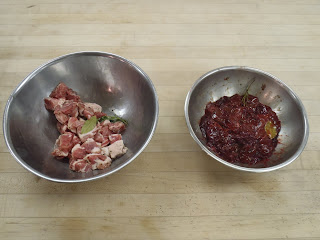 2: The next day, chill the meat grinder and mixer parts. Ice water is particularly effective. You can also preheat your oven to 300F.
2: The next day, chill the meat grinder and mixer parts. Ice water is particularly effective. You can also preheat your oven to 300F.
 3: After removing the bay leaf and thyme, sear the livers quickly over high heat. This is done strictly to enhance flavour and colour. Remove the livers from the pan and add minced shallots. Sautée briefly, then deglaze the pan with brandy to capture the sweet, sweet fond. Add the shallots and brandy to the livers and chill the mixture thoroughly.
3: After removing the bay leaf and thyme, sear the livers quickly over high heat. This is done strictly to enhance flavour and colour. Remove the livers from the pan and add minced shallots. Sautée briefly, then deglaze the pan with brandy to capture the sweet, sweet fond. Add the shallots and brandy to the livers and chill the mixture thoroughly.



 4: Searing the livers reduces the meats' willingness to bind and form a cohesive pâté. To help the liver and pork bind properly, a "panada" is added. This is exactly equivalent to the egg and bread crumbs our moms add to meatloaf or hamburgers. This panada is made of milk, cream, egg, and crustless white bread. Simply mix all the ingredients together with a fork.
4: Searing the livers reduces the meats' willingness to bind and form a cohesive pâté. To help the liver and pork bind properly, a "panada" is added. This is exactly equivalent to the egg and bread crumbs our moms add to meatloaf or hamburgers. This panada is made of milk, cream, egg, and crustless white bread. Simply mix all the ingredients together with a fork.

 5: Once the liver mixture is thoroughly chilled, combine the pork (bay and thyme removed), liver mixture, panada, and parsley, then pass through the meat grinder with a coarse plate. The plastic wrap in the picture below is draped over the grinder plate to prevent splatter (the livers are still bloody inside).
5: Once the liver mixture is thoroughly chilled, combine the pork (bay and thyme removed), liver mixture, panada, and parsley, then pass through the meat grinder with a coarse plate. The plastic wrap in the picture below is draped over the grinder plate to prevent splatter (the livers are still bloody inside).
 6: Mix the pâté. This develops a protein called myosin that gives the pâté a firm texture. Mix until the pâté develops a slightly sticky feel.
6: Mix the pâté. This develops a protein called myosin that gives the pâté a firm texture. Mix until the pâté develops a slightly sticky feel.
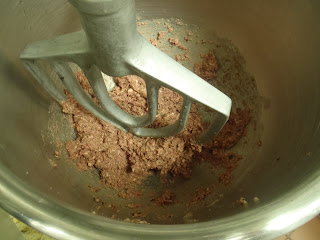 7: Quenelle test. Fry a small sample of the pâté to make sure it's properly seasoned. Since the pâté will be served at room temperature, the seasoning of the fried meat should be aggressive, but not overpowering (seasoning is easier to detect in hot food...)
7: Quenelle test. Fry a small sample of the pâté to make sure it's properly seasoned. Since the pâté will be served at room temperature, the seasoning of the fried meat should be aggressive, but not overpowering (seasoning is easier to detect in hot food...)
 8: Shape and bake. A pâté like this would traditionally be packed into a terrine lined with plastic wrap, like the one below:
8: Shape and bake. A pâté like this would traditionally be packed into a terrine lined with plastic wrap, like the one below:
 At the last minute I decided to bake my pâté in individual ramekins. Regardless of your cooking vessel, pack the meat tightly so that there are no air bubbles. Cracks and pocks mar the presentation, especially in smaller molds.
At the last minute I decided to bake my pâté in individual ramekins. Regardless of your cooking vessel, pack the meat tightly so that there are no air bubbles. Cracks and pocks mar the presentation, especially in smaller molds.
Place your ceramic vessel in a high-sided roasting tray. Fill the tray with hot water, up to the the level of the meat. I covered my pâté with plastic wrap with the idea of inhibiting browning and moisture loss, though I'm not sure it did anything.
 Cook in a low oven. For standard terrines, 300F is ideal. Since my pâtés were so small, I lowered my oven to 250F so that they would cook gently, and slowly enough that I could monitor them and pull them out at just the right time.
Cook in a low oven. For standard terrines, 300F is ideal. Since my pâtés were so small, I lowered my oven to 250F so that they would cook gently, and slowly enough that I could monitor them and pull them out at just the right time.
The internal finishing temperature should be about 150F. With a standard terrine this is easily measured by a digital thermometer. Unfortunately a thermometer would not work with these small pâtés. Most digital thermometers detect heat more or less along the whole length of their probe (or atleast the first couple inches). My pâtés, being only an inch deep, would not offer reliable measurements. I judged the doneness the old fashioned way: gently poking the surface of the pâté to test the firmness of the meat. Also, the pâté will be just, just starting to pull away from the sides of the ramekin once the meat is cooked.
9: Serving. I popped the pâtés out of their ramekins and seared them in a hot pan. This is emphatically not traditional, but the liver takes well to the browning flavour, and the crust is a good contrast to the creamy interior. Plus the sear reminds me of Mom's meatloaf.
The sauce was just sour cherries and simple syrup. Serve with toast.
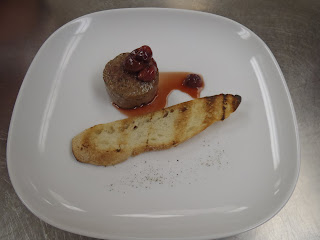
Potatoes? You gotta be poor to eat potatoes. Real poor.
-Tuco Ramírez in The Good, The Bad, and The Ugly
The importance of potatoes to my family was a slow revelation. I always knew from off-hand, quietly resentful remarks that when my parents were young they spent a lot of time tending to potato patches. Only recently did I fully understand the role potatoes played in their lives.
We usually consider bread to be the embodiment of simple, gratifying food. References to bread in European history, mythology, and religion are too numerous to count, but here are some highlights. Ample supplies of bread have often been the foundation of political stability. During the long period of decline, Roman emperors are said to have placated the masses with "bread and circuses," that is, by giving away bread and hosting spectacles like the gladiatorial fights. On the other hand, bread shortages incited riots during the French Revolution, which prompted Marie Antoinette's infamous proposal: "Let them eat cake". The Bible is replete with references to bread, where it is the main symbol of bodily nourishment. The two most notable references are in the Lord's prayer ("Give us this day our daily bread") and the breaking of bread during the last supper before Christ's death, which became the central sacrament of the Christian faith, in the form of communion.
Potatoes, being native to America, were unknown to Europe until the sixteenth century, weren't widely eaten there until the nineteenth century, and even then were considered peasant food. They don't have the benefit of biblical references, to say the least.
My parents grew up on farms in Ontario, and while they baked bread at home, potatoes were the staff of life. My mom ate potatoes twice a day almost every day of her childhood, usually fried potatoes with lunch and boiled potatoes with dinner.
 Her family grew them in huge quantities to last the winter. They were stored in the cool basement in crates with three solid walls and a fourth wall made out of slats stacked and held in place by grooves. The potatoes were sprinkled with lime (the chemical, not the fruit) to prevent rot.
Her family grew them in huge quantities to last the winter. They were stored in the cool basement in crates with three solid walls and a fourth wall made out of slats stacked and held in place by grooves. The potatoes were sprinkled with lime (the chemical, not the fruit) to prevent rot.
With this in mind, I have a dish to celebrate the potato: a dish befitting the nourishing, comforting, hearty character of the tuber. This ain't duchess potatoes or Vichysoisse. I'm talking about a potato broth with dumplings.
Potato Broth with Dumplings
Conversations about potato dishes usually focus on texture (the ideal French fry has a crisp exterior and fluffy interior, the ideal mashed potatoes are smooth but not gummy...) I love this broth because it makes you think about how potatoes taste. Potato skins are used to infuse a vegetable broth with potato flavour, without any of the thick starchiness we associate with potato soups.
Start with the dumplings. The key to pillow-like potato dumplings is to have as little moisture in the potatoes as possible. This way the milled potatoes will require less flour to form a dough, and there will be accordingly less gluten in the finished dumplings. Use low-moisture, starchy potatoes like russets.
Boil or bake the potatoes whole, with the skins on. Once they are cooked through and still hot, peel away the skins in large segments and mill the potatoes. Clouds of steam will escape in the process, ridding the flesh of excess moisture. Spread the milled potatoes on a sheet pan and cool thoroughly to let a maximum of moisture evaporate.
Lay your potato peels on a rack and dry thoroughly in a warm oven.

Once the potatoes have cooled, add flour and mix until a dough forms. To shape the dumplings, roll the dough flat, cut into strips, then cut the strips into rectangular pillows.

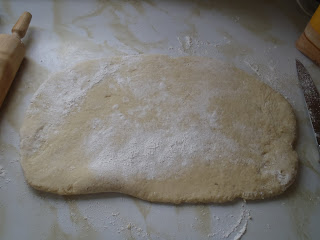

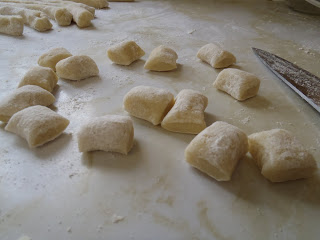
Now the broth. Make a simple vegetable broth by sweating onions, carrots, celery, and a touch(!) of tomato for colour and acidity. Add parsley, bay, and pepper. Cover with cold water and simmer for about an hour. Strain out the vegetables.
Add the crisp potato peels to the vegetable broth and simmer until you can taste the potato and the broth has reduced to a flavoursome concentration. Remove the peels before serving.

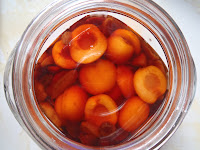 Rumtopf, literally "rum pot", is a traditional German fruit preserve. As each type of fruit comes into season, it is macerated with sugar, placed in the pot, then covered with rum. Traditional rumtopfs are earthenware pots with heavy lids, but any wide-mouthed, non-reactive vessel can be used.
Rumtopf, literally "rum pot", is a traditional German fruit preserve. As each type of fruit comes into season, it is macerated with sugar, placed in the pot, then covered with rum. Traditional rumtopfs are earthenware pots with heavy lids, but any wide-mouthed, non-reactive vessel can be used.
Earlier in the summer I added the precocious BC fruits, mostly cherries and apricots. This week I can add u-pick raspberries and strawberries.
I use about one part sugar to two parts fruit, by weight, for each addition.
The finished mixture steeps for a few months, and is usually eaten around Christmas. The fruit can be spooned over, say, ice cream, cake, or waffles, and the liquor can be drank on its own.
Every time I take off the lid to add more fruit I'm clubbed in the face with the delicate perfume of spiced rum and apricots. It's the height of folly to say this in the midst of our fleeting summer months, but I can't wait for Christmas.
 Cucumbers
Cucumbers

























